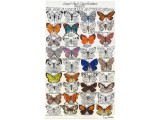Statement
Written by Dorothy Frisch
Seattle artist Gregory Blackstock was born in 1946, a time when the term autism was scarcely known. As was common then, his family physician gave the diagnosis of paranoid schizophrenia and, from the age of 10 to 15, Blackstock was sent far from home to special boarding schools for "troubled" children. After a stint at a local vocational school, he spent most of his life working menial, difficult jobs. He was well into adulthood before it became so clear he exactly fit the profile of an autistic person.
In his late twenties when working as a janitor in a hotel, he became fascinated with the various tools found in the maintenance room and began creating a large drawing titled, simply, “The Tools.” His mother, an artist, pronounced it “too big,” and Blackstock would let more than ten years elapse before he felt compelled to begin cataloguing the world in earnest, becoming ever more specific. For this childlike man, change can be distressing, and he evidently found it comforting to populate his world with things which could be satisfyingly labeled and organized, and are so reliably static.
Although he only draws subjects of immediate interest to him, he clearly uses this medium as an important communication tool with which to invite others into his world. He loves talking about his drawings to anyone who will listen, and often adds sound effects (race boat engines), mimes irritations (mosquitos) or recounts bits of his own history, which are related in many of his drawings (Montana scenes.) Referencing images culled from books, photos, and his own memory, Blackstock learns detailed information about each of his subjects, memorizing forever an astonishing range of geographical, anecdotal, and scientific information.
Beginning by drawing the title, the artist works down the page, first sketching an individual component in pencil, then outlining and captioning it in black marker. Finally, he uses colored pencils to shade in each image before moving on the next row. He will add paper, if necessary, to enlarge or edit the drawing, with little regard to precisely matching the tone or weight of material. Errors are corrected with WhiteOut, erasures, or tape, but once started, the drawing itself is never wholly rejected. Not only is the artist self-taught, but because each new work always involves a different subject, and much variety within that subject, Blackstock is simultaneously teaching himself how to draw each individual bird, building or butterfly at the moment he is rendering it on the final piece.
In addition to his categorical drawings, Blackstock often revisits music from his childhood, making hand-drawn, note-perfect (after changing to a more difficult key,) sheet music from tunes he heard decades ago, often at the roller rink. He frequently designs a decorative and informative cover, but then casually tosses the finished version onto a pile in the closet. When he is not drawing or working on his sheet music, Blackstock enjoys making lists of words, using a battered thesaurus as his guide. As nuance and verbal weight can be unfathomable to him, he spends hours reproducing and augmenting synonyms and antonyms, in an attempt to crack others’ elusive communication “code.” Like everything else he produces, these lists have their own distinctive artistic quality and inventiveness.
In 2004, a treasure trove of his rolled up drawings was at long last “discovered” by the art world and, since his first solo art show at age fifty-eight, Blackstock’s work has been shown in Geneva, Lausanne, New York, Miami, Philadelphia, San Francisco, Seattle, Paris and Vienna. The Seattle Art Museum and The Blanton Museum in Austin, Texas, own some Gregory Blackstock drawings. His pieces are also part of the Microsoft Art Collection and other important public and private collections. The prestigious Collection de l’Art Brut in Lausanne, Switzerland, holds an impressive body of the artist’s work. His images have been used in haute couture clothing by Comme de Garçons, as well as for gift cards and jigsaw puzzles. A book of his drawings, “Blackstock’s Collections”, was published in 2007 by Princeton Architectural Press.
Gregory Blackstock has been featured nationally and internationally in magazines, documentaries, and various scholarly works. His many exhibitions have garnered praise from art critics at home and abroad. One lengthy review by Robert Ayers in the Seattle Times ends with this:
“To assign him some peculiar status apart from other artists is a profound mistake. Gregory Blackstock is one of our city’s greatest artists; it’s as simple as that.”
Mr. Blackstock is represented by Greg Kucera Gallery in Seattle, Washington.
 |
 |
 |
 |
The World Nuisance Butterflies
2015
graphite, permanent marker, colored pencil on paper
41.5" x 24"
|
Historic Montana Spectaculars
2017
graphite, permanent marker, colored pencil on paper
46.5" x 24"
|
The Barracudas
2016
graphite, permanent marker, colored pencil on paper
40" x 24"
|
The Windmills
2014
graphite, permanent marker, colored pencil on paper
40.5" x 28.5"
|
 |
 |
 |
 |
The Great World Parrots
2014
graphite, permanent marker, colored pencil on paper
33.5" x 35 "
|
The Great American Art Museums Old & New
2017
graphite, permanent marker, colored pencil on paper
36" x 24"
|
The Historic Regular and Rare Student Model Petosa Accordions - Color Version
2016
graphite, permanent marker, colored pencil on paper
62" x 31 "
|
Thesaurus #9 Underworld
2016
graphite, permanent marker, ink on paper
32" x 17 "
|
|